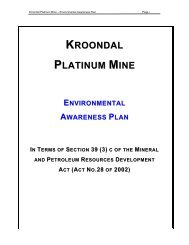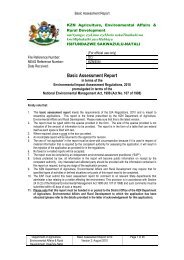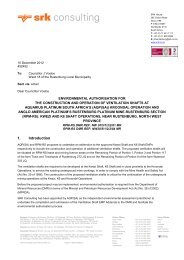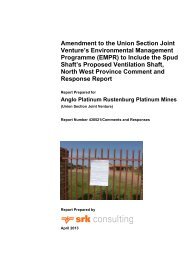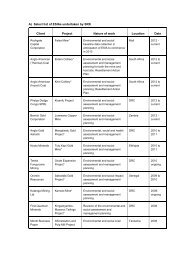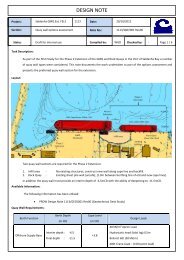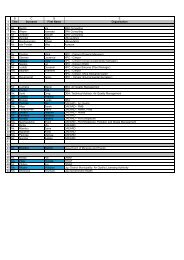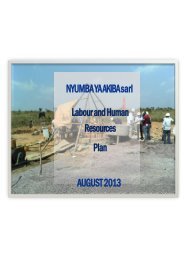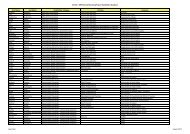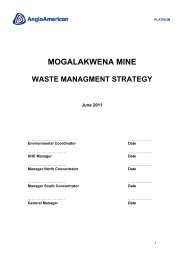Biodiversity (1 - SRK Consulting
Biodiversity (1 - SRK Consulting
Biodiversity (1 - SRK Consulting
You also want an ePaper? Increase the reach of your titles
YUMPU automatically turns print PDFs into web optimized ePapers that Google loves.
8.4 Discussion<br />
Four pertinent matters emerge from the list of mammals compiled during the site visit<br />
and the subsequent desktop study:<br />
5. the species assemblage is typical of a western semi-arid region (particularly species<br />
such as the elephants shrew species, the ground squirrel, the spectacled dormouse,<br />
the various gerbil species, the dassie rat, whistling rats, the black-footed cat, the bateared<br />
fox, the Cape fox, the gemsbok, the springbok etc.);<br />
6. the species richness of 56 is typical of an extensive area such as the property (5000<br />
ha) and of adjoining areas, with a near-natural degree of connectivity;<br />
7. land-use practices and civilization pressures are geared to low-key grazing with a<br />
focus on concomitant floral conservation to benefit year-round grazing, which are<br />
conducive to species richness; and<br />
8. field observations suggested that population levels were low during the site visit.<br />
Population fluctuations are not uncommon, and often have a domino effect (for<br />
instance when prey population densities decrease in numbers, this will have an<br />
adverse effect on carnivore and raptor numbers).<br />
The rest of the species richness is made up from common and robust mammals with<br />
wide distributional ranges such as aardvarks, springhares, four-striped grass mouse,<br />
porcupines, the caracal, the genet, the two mongoose species, the black-backed jackal<br />
etc.<br />
The role of insectivorous bats in an ecosystem is often under-estimated, whereas their<br />
susceptibility to reigning environmental conditions is under-appreciated. Bats are<br />
sensitive to adverse daytime environmental conditions and predation, and suitable<br />
daytime roosting sites are of cardinal importance. Especially the Bobbejaansgat<br />
Mountain has many boulders and rock faces forming many overhangs and deep crevices<br />
suitable for daytime roosts. The dammed water and marshland conditions in the Koa<br />
River Wash to the north-east of the site are likely to support insect populations for<br />
hawking bats.<br />
86



